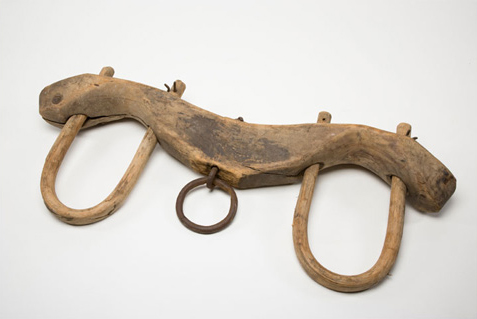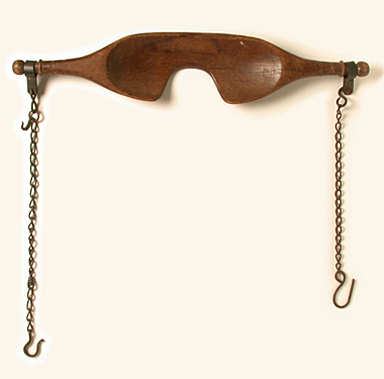At Tehaphnehes also the day shall be darkened,
when I shall break there the yokes of Egypt:
and the pomp of her strength shall cease in her.
Yield not thy neck to fortune’s yoke,
but let thy dauntless mind still ride
in triumph over all mischance.
Called oxbows —a name lent long ago to a common feature of nearly every free-flowing watercourse, where a stream’s channel bends back upon itself—the two U-shaped pieces (usually hickory wands) are held snugly in place with metal keepers inserted through holes bored in the wooden bows. The tongue of a wagon or a chain from a sledge is fastened to the iron ring, which is suspended from a U-shaped iron rod called a staple. Many other designs utilizing the same principle have been used, but this is the one most often found in North American agriculture until the end of the 19th century.
The word yoke can denote a type of wooden device used for many centuries past, and still today in various parts of the world, to harness animals that have been bred and trained to pull heavy loads, known as draft animals.[1]Throughout the Middle East, the Far East, and Africa, water buffalo are used for this purpose. In Western countries draft horses such as percherons, Belgians, or clydesdales are usually harnessed … Continue reading Prior to the advent of the steam engine, heavy pulling in Europe and America was most often done by pairs—or yokes—of oxen (castrated male cows). Two types of yokes were used. Pairs of short-horned animals were often harnessed to head yokes, which set on their foreheads in front of their horns. More practical, and therefore more common, was the yoke that rested on the animals’ shoulders. It was fitted snugly to their necks, to insure that they would share the load equally. One ox harnessed to a single collar could be used for light pulling. Bovines have been used as draft animals more often than equines because horses and mules tend to throw their weight against the harness and jerk the load into motion, whereas oxen naturally have what might be called a super-low gear that enables them to make smoothly controlled starts.
On the Ohio River
A shoulder yoke, still in use in some parts of the world, is used to enable one person to carry two separate loads of equal weight. This view looks upward from below the yoke, with the concave part resting on the carrier’s shoulders and the curved notch to admit his or her neck. If the carrier stands and walks erect, the shoulder yoke places the weight of the loads close to the body on both sides, and straight down upon the hips and legs, allowing combined loads of 100 pounds or more to be transported without injury to the carrier.
Draft animals were required to get the Lewis and Clark expedition under way. On 31 August 1803, the day Captain Lewis and his eleven-man crew left Pittsburgh on the barge (called the ‘boat’ or ‘barge’ but never the ‘keelboat’). Shortly after passing Brunot’s Island, Lewis and his crew had to get into the water and drag the boat over a 30-yard riffle at McKee’s Rock. Soon they encountered another gravel bar, and barely made it over a third riffle before halting for the night. The next morning they negotiated Little Horsetail Riffle with great difficulty—”all hands laboured in the water about two hours before we effected a passsage.” Soon they confronted Big Horsetail Ripple; there they had to unload the boat and lift it over the obstruction. At about 5 o’clock Lewis had to hire a man with a team of oxen to help him and his crew drag the barge over a riffle appropriately known as Woolery’s Trap. Setting out at sunrise on 2 September 1803, they struck the first riffle within 21/2 miles. At 9 o’clock they reached Logtown Riffle, where they had to unload the barge, drag it over the shoal, then reload the boat. The whole process took four hours. Only a short time later they were stranded again, until they located a farmer with one horse and an ox. (Having necks and withers of naturally different widths, the horse probably wore a horse collar, the ox a head yoke. Lewis “payd the man his charge which was one dollar.”) It wasn’t long before they encountered a sandbar—the fifth riffle of the day—where “the boat rubbed for some distance but by geting out and pulling her on by the thwarts we got her over.”
Early on the morning of the 6th the barge struck a riffle that they soon “got over with some difficulty and in the distance of two miles and a half passed 4 others three of which we were obliged to drag over with horses.” Soon after they passed Steubenville, Ohio, the wind rose enough to propel them some distance by their lateen sail, until a sudden gust broke the sprit. Two miles below town they got stuck on another riffle, and hoisted their mainsail in the hope that the wind would drive them over it, but the wind broke that also. “Now having no assistance but by manual exertion and my men woarn down by perpetual lifting I was obliged again to have recourse to my usual resort and sent out in serch of horses or oxen. . . . the oxen arrived got off with difficulty the oxen drew badly however with their assistance we got over two other riffles which lyed just below.” They set out the next morning at 7:30, and “in about two hundred paces stuck on a riffle all hands obliged to get out” and lift the boat over by the thwarts.
They spent the night of 8 September 1803 at Wheeling, West Virginia. In a report to President Jefferson, Lewis reflected on his journey to date. Even for that late in the travel season the Ohio River was, Lewis wrote, “lower than it has ever been known by the oldest settler in this country,” and it continued to fall a little more every day. On many gravel bars—called riffles by folks along the Ohio, Lewis remarked, “the water in the deepest part dose not exceed six inches,”[2]Jackson, Letters, 1:122. whereas the barge needed three feet of it just to stay upright in the water. On 13 September 1803 at Marietta, Ohio, he wrote a follow-up report. The 100-mile stretch of the Ohio from Wheeling was deeper than that from Pittsburgh, although twice he had had to call on oxen or horses to get past riffles. Those animals were, he acknowledged reluctantly, were the last resort. “I find them the most efficient sailors in the present state of the navigation of this river, altho’ they may be considered somewhat clumsey.”[3]Ibid, 1:124.
Metaphor for Oppression
Noah Webster, in his Compendious Dictionary of the English Language (1806), defined the noun yoke as “a bandage on the neck, chain, bond, bondage, mark of servitude, couple, pair.” As a verb he defined it as “to couple or join together, to enslave.” Undoubtedly one of the oldest words in the lexicon of animal husbandry, it has had two shades of meaning since long before Biblical times.
On the one hand, the union seeming to exist between two tractable oxen yoked together has made the word a useful metaphor for the willing and productive sharing of a task or burden. The apostle Paul wrote, in his letter to the Philippians (4.3): “I entreat thee also, true yokefellow, help those women which laboured with me in the gospel,” and Matthew (11.30) quoted Jesus: “my yoke [is] easy, and my burden is light.” Similarly, the English poet James Thomson (1700-1748), with whose epic poem The Seasons Meriwether Lewis was well acquainted, wrote in Spring of compliant bovines who, “unrefusing, to the harness’d yoke/ . . . lend their shoulder and begin their toil,/Chear’d by the simple song and soarin lark.” However, the opposite connotation, “bondage” or “servitude,” is more frequently seen in literature from the Bible and the Koran to the writings of 18th century historians. In his epochal, six-volume History of the Decline and Fall of the Roman Empire, which was published between 1776 and 1789, the English historian Edward Gibbon (1737-1794) used the metaphor of the yoke 116 times, almost always in the specific sense of an oppressive political or religious power. He cited Charles Martel’s victory over the Saracens at the Battle of Tours, France, in 732 C.E., which effectively halted Islamic expansion into western Europe, and “saved his country . . . from the Mahometan yoke.”[4]Edward Gibbon, The History of the Decline and Fall of the Roman Empire, ed. by Dean Milman, M. Giozot, and William Smith, 6 vols. (New York: J. W. Lovell, 1856), 5:23.
Meriwether Lewis once used that same expression, “the Mahometant yoke”, in a somewhat different sense (see Barbary Coast War).
Notes
| ↑1 | Throughout the Middle East, the Far East, and Africa, water buffalo are used for this purpose. In Western countries draft horses such as percherons, Belgians, or clydesdales are usually harnessed with individual padded horsecollars. The breeding, training, and roles of oxen in the history of American agriculture are discussed in the Colonial Williamsburg® web page, “Smart as an Ox: Beasts of Burden Bright, Gentle, and Strong,” by Ed Crews, at http://www.history.org/Foundation/journal/Spring08/oxen.cfm (accessed 10 December 2009). |
|---|---|
| ↑2 | Jackson, Letters, 1:122. |
| ↑3 | Ibid, 1:124. |
| ↑4 | Edward Gibbon, The History of the Decline and Fall of the Roman Empire, ed. by Dean Milman, M. Giozot, and William Smith, 6 vols. (New York: J. W. Lovell, 1856), 5:23. |


